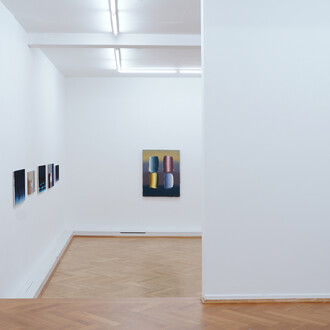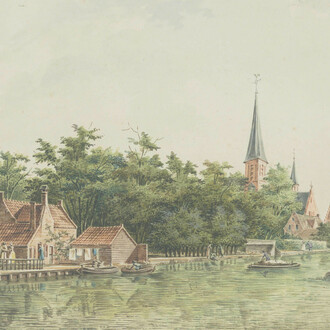What therefore is the organism in the world, if not the unconsidered flight of a possible into the heart of the impossible that surrounds it?
(George Bataille, The Congested Planet, from: The Unfinished System of Nonknowledge)
I approach these canvases as notes, keeping them sketch-like and incomplete. They give form to a state of the rudimentary appearances of things and a structure that marks thought processes.
I started this line of paintings last year, back then as a survey on what deviates from the norm, of border experiences and border transgressions, an anthropological approach to a world gone off rail. An imaginative thinking of things to its end; as a fictional representation of an alternative, post- or pre-temporaneity. Now, the affirmative action of the poetic imagination has become a means of achieving resilience towards real circumstances. I am looking for a way to overcome certain ideas and ways of thinking that tend to suffocate in a type of everyday semantics of conventionalist classification. I think that as long as poetry is possible – as the longing for the impossible – a kind of hope can be possible. I see art as a means of reality to gain consciousness about itself.’
(Fabian Herkenhoener, May 2020)
The reality experience (that no longer lends itself to a reliable structure) of a time that we are currently experiencing as a “crisis” – and which is also felt as a loss of a reality that we had taken for granted – highlights what has long been veiled by habit. Crises, dubiousness and uncertainty; fragility in many parts of society and in nature; the search for truth and reality, for our existence as individuals and together with others; ruptures and ambivalences and emptiness or isolation – these things are not new but have merely come more to the fore in the current situation, laying bare all weaknesses. In this context, Fabian Herkenhoener’s pictures read like reflective, often ironic comments on this state of affairs.
The titles and linguistic notes of the works manifest themselves on the one hand as if in passing and, on the other hand, with physical presence on the pictures, opening up a whole new level of meaning. They penetrate the openness of the painting through ironic components that they add disconcertingly, and through their material existence, which appears to summon up an almost stubborn contrast to the openness of the picture and, by the same token, to the resolution of the object status of pictures and language in the contemporary digitised reality. They are clearly there, tangible and in palpable contrast to the void upon which they are commenting through the medium of words. With their ironic rejectionist attitude towards prevailing circumstances, they often call to mind the avant-garde word experiments of the Dadaists, which also crop up again in the Fluxus movement, in which language is used as a symbol for communicating on a level of perception that goes beyond semantic meanings and narrative logic. It is a perception of reality that, much like the demands of futuristic literature, corresponds to a “vision of the world” in which free associations come together to form a poetry of the present. Meanwhile, Fabian Herkenhoener uses language as a medium for an alternative experience of reality, far removed from everyday life. The artist himself calls it anthropological stocktaking of an unhinged world.
The language takes on the vanishing point of poetry – the moment in which it veers into unchartered waters, where being liberated from a specific purpose means opening up to the universal – here, reality becomes penetrable and open for the impossible and can only be sensed or guessed. It is a way of grasping things in their non-tangibility, thus offering an alternative to emptiness.
Ann-Katrin Günzel, May 2020
















